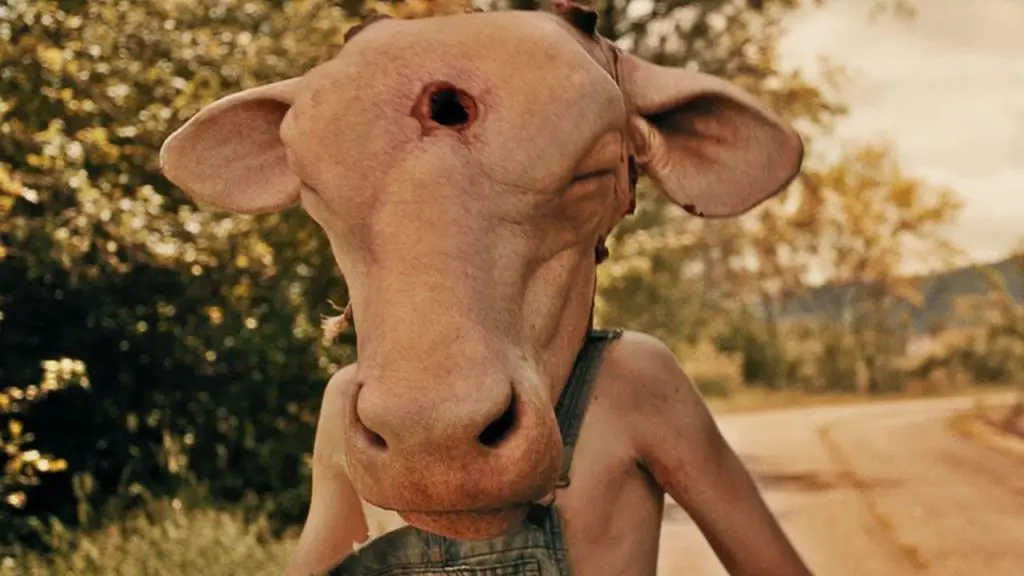I’ve long since stopped trying to keep track of the continuity that has been relentlessly contorted by the seven sequels and reboots of variable quality since Tobe Hooper’s 1974 landmark of hillbilly horror, The Texas Chainsaw Massacre. The latest installment, Leatherface, pitches itself as a canonical prequel to the original, thus overwriting the sins of previous attempts at origin stories – not that there has ever been a franchise that needed one less.
No matter. We’re back at the ramshackle Sawyer family farm in the rural Texas of 1955, where a young Jed Sawyer (Boris Kabakchiev) proves a disappointment to his maniac mother, Verna (Lili Taylor), by refusing to dismember an unfortunate fella they’ve got tied up at the dinner table. Luckily he earns his stripes by playing his dutiful role in a roadside ambush, donning a macabre cow’s head to lure a passing couple into a deadly trap. It just so happens that the victim here is the daughter of local Texas Ranger Hal Hartman (Stephen Dorff), who, because he lacks the evidence to convict Verna, instead arranges for young Jed to be committed to a state mental infirmary, Gorman House.
Fast-forward ten years, and meet Lizzy White (Vanessa Grasse), a new nurse at the gothic institution where the mentally infirm are periodically subjected to a sadistic regime of electroconvulsive “therapy”; the smoke wafting from the treatments smells faintly of One Flew Over the Cuckoo’s Nest. Verna has married into money, but her latest legal bid to regain custody of Jed is stymied by some bureaucratic manoeuvring, and the hilariously contrived fact that his name has been changed (we’re told for his own protection). This is one of the dumbest plot devices I’ve seen for some time, but its purpose is to keep viewers in the dark about which of our main characters is destined to become Leatherface – an objective the film succeeds at, mostly by tricking audiences into thinking it’s cleverer than it ultimately reveals itself to be.
A riot – in no small part caused by Verna – results in Lizzy being kidnapped by a gang of escapees, who also double as our potential suspects: the childlike not-so-gentle giant Bud (Sam Coleman); the protective and supremely likeable Jackson (Sam Strike); and a bloodthirsty, unstable Bonnie and Clyde-style couple, Ike (James Bloor) and Clarice (Jessica Madsen). On their trail is Dorff’s sweaty, vengeful lawman, who is becoming increasingly unhinged, and his deputies – one of whom is played by Finn Jones, aka the Immortal Iron Fist. (He’s much better here than he was there.)
This is all brought to us by the French filmmaking duo of Alexandre Bustillo and Julien Maury, who’re making their English-language debut. And, believe it or not for a franchise that has seemingly made a concerted effort to sully the good name of the classic original film, what they’ve accomplished with Leatherface is a pulpy shocker that strikes me as one of the better attempts at the character since that seminal starting-point. It’s a little too unnecessarily mean-spirited, sometimes in a way that feels counter-productive, but as a distracting piece of cinema designed to provide a splattery reason for the iconic villain’s connection to his family (and his saw), it does the job.
This isn’t a wildly original reboot, and it holds off from being a Texas Chainsaw film until its final moments, when the story returns to the Sawyer farmhouse in a typically full-circle coming-of-age conceit. But the journey there manages to incorporate a handful of unpleasant deviations, including a shotgun massacre at a roadside diner, and a necrophiliac orgy that reminded me of my last Fresher’s Week excursion. But these are the expected thrills of genre movies, and while Leatherface is formulaic and predictable, it has a foul energy, and a climactic bloodbath that feels like the long-still blade of the franchise’s signature weapon starting to rev up once again.




